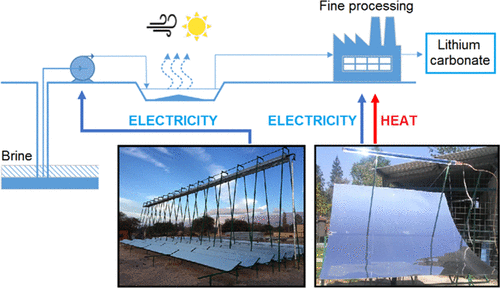当前位置:
X-MOL 学术
›
Energy Fuels
›
论文详情
Our official English website, www.x-mol.net, welcomes your feedback! (Note: you will need to create a separate account there.)
CO2 Emission Reduction by Integrating Concentrating Solar Power into Lithium Mining
Energy & Fuels ( IF 5.3 ) Pub Date : 2021-09-21 , DOI: 10.1021/acs.energyfuels.1c01951 Pablo Dellicompagni 1 , Judith Franco 1 , Victoria Flexer 2
Energy & Fuels ( IF 5.3 ) Pub Date : 2021-09-21 , DOI: 10.1021/acs.energyfuels.1c01951 Pablo Dellicompagni 1 , Judith Franco 1 , Victoria Flexer 2
Affiliation

|
An assessment of the energy requirements in the lithium brine mining and processing industry indicated that all active facilities currently satisfy their energy needs from fossil fuels. A more detailed analysis of two case studies allowed us to identify specific thermal and electrical energy requirements. Annual horizontal global solar irradiation values higher than 2000 kWh/m2 are registered at most lithium brine deposits. These values make concentrating solar power (CSP) an interesting technology to supply mining activities with alternatively thermal or electrical energy, both from technological and economical perspectives. The temperature and heat consumption of the processes were considered as reference parameters to determine the thermal capacity of solar power plants. These plants were designed using the system advisor model. Furthermore, CO2 mitigation was analyzed. A parabolic trough plant for power electric generation with a thermal storage system was found to be a more suitable option to substantially diversify the energy matrix and reduce greenhouse emissions of the lithium mining industry, if compared with using CSP for thermal processes in the absence of energy storage. Simulation results showed similarities in the emission reduction potential when parabolic trough and linear Fresnel technologies without thermal storage were compared: 154.3 and 161.6 gCO2/kgLCE, respectively. On an annual basis, these technologies cover over 20% of the thermal energy matrix. An electric plant designed based on a parabolic trough system coupled to thermal energy storage can achieve a matrix penetration of over 51% and an annual CO2 mitigation of 403.3 gCO2/kgLCE.
中文翻译:

通过将聚光太阳能发电集成到锂矿开采中来减少二氧化碳排放
对锂卤水开采和加工业能源需求的评估表明,所有活跃的设施目前都通过化石燃料满足其能源需求。对两个案例研究的更详细分析使我们能够确定特定的热能和电能需求。年水平全球太阳辐射值高于 2000 kWh/m 2在大多数锂卤水矿床中注册。这些价值使聚光太阳能 (CSP) 成为一项有趣的技术,可以从技术和经济角度为采矿活动提供热能或电能。这些过程的温度和热量消耗被认为是确定太阳能发电厂热容量的参考参数。这些工厂是使用系统顾问模型设计的。此外,CO 2对缓解进行了分析。与在没有能源的情况下将 CSP 用于热过程相比,具有热存储系统的抛物线槽式发电设备被发现是一种更合适的选择,可以显着多样化能源矩阵并减少锂采矿业的温室气体排放贮存。模拟结果表明,当抛物线槽技术和线性菲涅耳技术没有蓄热器进行比较时,其减排潜力相似:分别为 154.3 和 161.6 gCO 2 /kg LCE。每年,这些技术覆盖了超过 20% 的热能矩阵。基于与热能存储耦合的抛物线槽系统设计的发电厂可以实现超过 51% 的矩阵渗透率和年二氧化碳排放量2 403.3 gCO 2 /kg LCE 的缓解。
更新日期:2021-10-07
中文翻译:

通过将聚光太阳能发电集成到锂矿开采中来减少二氧化碳排放
对锂卤水开采和加工业能源需求的评估表明,所有活跃的设施目前都通过化石燃料满足其能源需求。对两个案例研究的更详细分析使我们能够确定特定的热能和电能需求。年水平全球太阳辐射值高于 2000 kWh/m 2在大多数锂卤水矿床中注册。这些价值使聚光太阳能 (CSP) 成为一项有趣的技术,可以从技术和经济角度为采矿活动提供热能或电能。这些过程的温度和热量消耗被认为是确定太阳能发电厂热容量的参考参数。这些工厂是使用系统顾问模型设计的。此外,CO 2对缓解进行了分析。与在没有能源的情况下将 CSP 用于热过程相比,具有热存储系统的抛物线槽式发电设备被发现是一种更合适的选择,可以显着多样化能源矩阵并减少锂采矿业的温室气体排放贮存。模拟结果表明,当抛物线槽技术和线性菲涅耳技术没有蓄热器进行比较时,其减排潜力相似:分别为 154.3 和 161.6 gCO 2 /kg LCE。每年,这些技术覆盖了超过 20% 的热能矩阵。基于与热能存储耦合的抛物线槽系统设计的发电厂可以实现超过 51% 的矩阵渗透率和年二氧化碳排放量2 403.3 gCO 2 /kg LCE 的缓解。



























 京公网安备 11010802027423号
京公网安备 11010802027423号